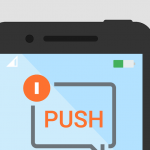7 tips to help retailers bring web‑notification practices up to date

The latest version of Google Chrome (v80) just joined Mozilla Firefox (v72) and Apple Safari (v12.1) in putting marketers on notice: Adopt notification best practices or risk seeing a massive customer engagement channel wither. The latest versions of each browser have added user-centric controls and changed the way they prompt users for web notifications.
Honestly, it’s about time. We’ve all been annoyed visiting a website for the first time only to receive an opt-in system prompt immediately. This blunt-force and all-to-common method not only impedes users in accomplishing their immediate tasks, but it also fails to build any reason or value for why they should consider opting in. It engenders a knee-jerk reaction that, over time, evolves and becomes a reflex, where many people say no.
With these browser changes, websites that ask for opt-in immediately will now be relegated to quiet notification prompts, which appear as an icon in the address bar for Chrome and Firefox (Safari blocks this altogether). These quiet prompts are much less visible than the standard system prompt that appears below the address bar.
Additionally, users now have browser settings that are somewhat indiscriminate. In one fell swoop, they can block all websites from asking for opt-in. In Chrome, users can choose to receive all opt-in requests quietly. Chrome goes even further, automatically enrolling users in quiet prompts if they usually decline website notifications and limiting the number of users that will see these prompts for websites with low opt-in rates.
Many retailers have experienced tremendous success with web notifications, which reach users in real-time, whether they are on the brand’s website or anywhere else on the web. For instance, within one year of launching web notifications, Asda’s George.com saw an incredible 40% conversion rate on abandoned carts and a 27% clickthrough rate on segmented notifications, such as exclusive offers targeted to loyalty customers. And American Eagle Outfitters exponentially increased its addressable Android audience in the first three months of adopting web notifications.
How to achieve superb engagement
Web notifications have become a vital channel for marketers with audiences that regularly surpass the number of customers that opt into emails or app notifications. It’s critical marketers take action now to preserve and grow this channel. Brands that commit to using smart web notifications, borrowing from years of app best practices, can continue to expand their reach and serve more customers in highly personal, valued ways. Here are our top seven tips:
- Make the value of opting in clear: Now, more than ever, you need to ensure you are conveying the value of your website messaging. Will subscribers get exclusive offers or content? Do notifications streamline essential customer journeys, like knowing when your product shipped? Are there important features or even in-store experiences that utilize web notifications? Always surface these benefits and value in a soft-prompt before triggering the browser’s system notification prompt.
- Prioritize preferences: Provide website visitors a preference center and make sure they understand up front that users can customize their notification settings to receive only the notifications they want when they want it. For example, a retailer might offer daily flash sale notifications, weekly specials, or most significant seasonal sales as ways to give visitors choices, while providing separate categories for transactional messages like shipping notifications and loyalty programs. The more exacting people can be in controlling notification content, the happier they will be to see it arrive.
- Carefully consider when to ask for the opt-in: Rather than triggering opt-in prompts as soon as visitors arrive on your site, consider waiting until they’ve taken an action that signals interest. Have they clicked into a product category, viewed special promotions, read two articles, or added something to their cart? Try to identify where in the customer journey asking for the opt-in is more helpful than hindering.
- Experiment and test different opt-in flows: As website opt-ins are many marketers’ largest addressable audiences, there’s sound logic for not waiting too long before making the ask as fewer visitors will see it. Between timing, language, unique offers and delays between prompting individuals again, many variables can be A/B tested against control groups to help retailers arrive at optimal executions. Remember, this is an ongoing process. While browsers will judge your site by opt-in rate, what matters to your business is a more significant long-term engagement, more conversions, greater frequency and higher lifetime values.
- Cover your bases: Retailers can use the same type of experimentation to get people to opt into other marketing channels, whether it’s your email list, your text messaging club, or adding a mobile wallet coupon, loyalty, or warranty card. Each of these channels gives you more opportunity to engage your base at various levels of visibility, orchestrating messaging across them to create better customer experiences.
- Get to know your website visitors to make every push count: Messages, especially notifications, are interruptions, so make them welcomed by being tailored to individuals’ needs and interests. Marketers should use everything they know about visitors—exhibited behaviors, stated preferences, current journeys and transactional histories—to make every message as relevant as possible. Highly targeted messages get five to seven times better response rates than broadcast messages, and they are much less likely to result in visitors opting out.
- Build functionality that makes opt-in an easy decision: There’s a reason that the overall average notification opt-in rate for apps is above 50% and climbing. In essence, notifications have become core functionality with both apps and mobile platforms, offering greater controls and richer experiences. Marketers should consider building programs that provide VIP treatment; for example, offering double loyalty point days, early access to your biggest sales or notifications when wish list items go on sale.
It’s up to retail marketers to make their messaging worth everyone’s time by offering customers something of value. This sensibility will give brands a human touch, creating experiences that speak to earnest intent rather than coming off as just another ping.
___
by Mike Stone
source: Digital Commerce 360

